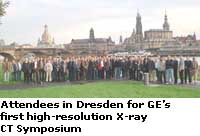First high-resolution X-ray CT Symposium from GE proves great success
06/10/2010
 The first high-resolution X-ray computed tomography (CT) symposium hosted by the phoenix|x-ray product line of GE’s Inspection Technologies business has proved an eminent success, attracting more than 120 delegates from 20 countries. With papers presented by 34 speakers and with a further 14 poster presentations, the symposium took place in Dresden, Germany, from 31 August to 2 September.
The first high-resolution X-ray computed tomography (CT) symposium hosted by the phoenix|x-ray product line of GE’s Inspection Technologies business has proved an eminent success, attracting more than 120 delegates from 20 countries. With papers presented by 34 speakers and with a further 14 poster presentations, the symposium took place in Dresden, Germany, from 31 August to 2 September.The aim of the event was to provide a forum for information sharing and discussion on the latest developments in CT technology and its application in fields as diverse as 3D metrology, materials science research, geosciences, failure analysis and non-destructive testing and biomedical research.
As Juan Mario Gomez, General Manager, Radiography at GE’s Inspection Technologies business, enthused: “The success of the symposium is further demonstration of the increasing importance of this exciting technology and I am proud that we have been able to take the leading role in arranging this event, which brought together experts and CT users from all over the world – from Iceland to Israel and from the USA to Russia. There were papers from universities and academic institutions explaining the involvement of CT in the latest cutting-edge research, as well as presentations from industrial and laboratory CT users, who are using the technology to solve real problems, save inspection time or gain greater insight into processes and the structural behaviour of specific materials.”
Oliver Brunke, the phoenix CT Product Manager, who co-chaired the symposium, also took the opportunity to introduce the latest phoenix developments in hardware and software for high-resolution CT systems.
In CT, X-ray images are taken of an object at precise angular intervals as it rotates. These individual projections are then numerically reconstructed by sophisticated software to produce a high-resolution, 3D volume image. Just a few of the current applications of CT include inspecting castings for defects, checking the integrity of PCBs and electronic circuits, examining the deformation of composite materials under impact, petrophysical research to help in oil reservoir management, qualification of injection-moulded polymer parts, visualisation of biological tissues and imaging plant roots to investigate root/soil interaction.
www.gesensinginspection.com